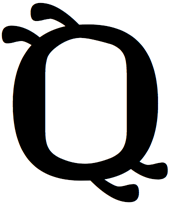Glagolitic Capital Letter Spidery Ha
 A great Unicode in 5 Minutes presentation from Mark Lentczner at Linden Lab. He passed it along after reading this dense post, clearly concerned about the welfare of my readers.
A great Unicode in 5 Minutes presentation from Mark Lentczner at Linden Lab. He passed it along after reading this dense post, clearly concerned about the welfare of my readers.
(Searching out the image for the title of this post also led me to a collection of Favourite Unicode Codepoints. This seems ripe for someone to waste more time really tracking down such things and documenting them.)
Mark’s also behind Context Free, one of the “related initiatives” that we have listed on Processing.org.
Context Free is a program that generates images from written instructions called a grammar. The program follows the instructions in a few seconds to create images that can contain millions of shapes.
Grammars are covered briefly in the Parse chapter of vida, with the name of the language coming from a specific variety called Context Free Grammars. The magical (and manic) part of grammars is that their rules tend to be recursive and layered, which leads to a certain kind of insanity as you try to tease out how the rules work. With Context Free, Mark has instead turned this dizziness into the basis for creating visual form.
Updated 14 May 08 to fix the glyph. Thanks to Paul Oppenheim, Spidery Ha Devotee, for the correction.

